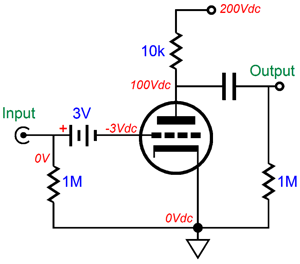Hello.
I'm trying to experiment different ways to optimize the first stage of tube amplification via cathode bias....I've read that an easy way is with the use of a LED, with certain characteristics. It has to be able to work with low current and have the lowest internal resistance, traducing in less dynamic impedance, which finally affects the sound.
Since such a LEDs are not so common and also fair expensive, is there any (valid and cheap) alternative to them? Thanks
I'm trying to experiment different ways to optimize the first stage of tube amplification via cathode bias....I've read that an easy way is with the use of a LED, with certain characteristics. It has to be able to work with low current and have the lowest internal resistance, traducing in less dynamic impedance, which finally affects the sound.
Since such a LEDs are not so common and also fair expensive, is there any (valid and cheap) alternative to them? Thanks
I've found just about any of the HLMP series LEDs will fit the bill.
Yes, the HLMP-6000 series seems to be the most fitting: the problem is that it's hard to find (here). I've heard that there are some old leds working even better, one should experiment and see...
Seriously… you could also and cheaply use a string of common 1N4001 thru 1N4007 diodes too. Each of them introduces about 0.77 V (at single-digit milliamps) drop. Pretty convenient as a step-ladder setup. Just put 10 of them in series, tap wherever you want in 0.77 volt increments.
Nowhere near as 'pretty' as LEDs, but darn cheap, and with very very good current-transient and dozens-to-hundreds of milliamps capabilities. Did I mention cheap? 7¢ to 14¢ at most every supplier. Buy 100. Keep em in stock.
GoatGuy (PS: you could also put a front-panel rotary switch to change the tap-point on the fly, to try out different bias voltages without otherwise having to physically modify your preamp section. HOW COOL IS THAT?)
Nowhere near as 'pretty' as LEDs, but darn cheap, and with very very good current-transient and dozens-to-hundreds of milliamps capabilities. Did I mention cheap? 7¢ to 14¢ at most every supplier. Buy 100. Keep em in stock.
GoatGuy (PS: you could also put a front-panel rotary switch to change the tap-point on the fly, to try out different bias voltages without otherwise having to physically modify your preamp section. HOW COOL IS THAT?)
(PS: you could also put a front-panel rotary switch to change the tap-point on the fly, to try out different bias voltages without otherwise having to physically modify your preamp section. HOW COOL IS THAT?)
Yes, really cool that...I'd have just a 10 position rotary switch abandoned in a drawer!
Yes, the HLMP-6000 series seems to be the most fitting: the problem is that it's hard to find (here). I've heard that there are some old leds working even better, one should experiment and see...
RS Amidata & Farnell have.
RS Components | componenti elettronici ed elettrici
http://it.farnell.com/
Bulk Chinese leds
See http://www.diyaudio.com/forums/tubes-valves/183329-4p1l-se-66.html#post3611427 - testing a bag of no-name leds from epay with 20 of each color showed that yellow ones have very low and flat impedance (with current typically used in tube amps).
See http://www.diyaudio.com/forums/tubes-valves/183329-4p1l-se-66.html#post3611427 - testing a bag of no-name leds from epay with 20 of each color showed that yellow ones have very low and flat impedance (with current typically used in tube amps).
See http://www.diyaudio.com/forums/tubes-valves/183329-4p1l-se-66.html#post3611427 - testing a bag of no-name leds from epay with 20 of each color showed that yellow ones have very low and flat impedance (with current typically used in tube amps).
Interesting table, how did you calculate the final impedance of the LEDs shown?
Bias with a battery in series with the grid. No current flows and a carbon cell will last decades.

I guess the only real caveat would be to remember that the relatively big dry cells are also pretty good “interference antennas”. Like big bare wires. You can (and probably should) mount the cells in a shielded battery holder, wrapped with copper foil, connected to ground.
The “lasts 10 years” depends almost entirely on whether the packaging of the cells lasts 10 years. Of recent, I've noticed that 5–6 years seems to be the design spec. Kind of sad.
GoatGuy
I've found the cheapest ones work best. Go figure. Use carbon zinc cells in a paper sleeve (like the old Eveready). For that matter you can use heading aid batteries to decrease the size. My personal best was a C sized dry cell in a 1950's Eico VTVM. It was still putting out 1.54V open circuit after all those years.
Last edited:
The 1Nx types are noisy. Also, the forward voltage varies quite a bit with temperature..use a string of common 1N4001 thru 1N4007 diodes
- Status
- This old topic is closed. If you want to reopen this topic, contact a moderator using the "Report Post" button.
- Home
- Amplifiers
- Tubes / Valves
- LED choice in cathode biasing